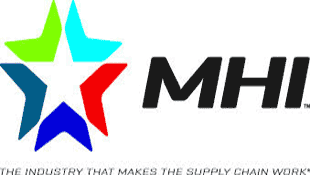MHI, the trade association for the materials handling industry, celebrates its 75th anniversary this year after its founding in 1945.
As part that celebration, MHI 's Solutions magazine recently brought together a panel of experts to identify the most consequential materials handling-related innovations over those 75 years.
Supply Chain Digest Says... |
|
|
The expert panelists were as follows:
• John Hill, Director at St. Onge Company
• Bryan Jensen, Chairman and Executive Vice President of St. Onge Company
• John Nofsinger, former CEO of MHI
• John Paxton, COO and CEO Designate of MHI
• Jim Tompkins, chairman of Tompkins International
The 10 top innovations identified by this group are listed below:
Pallets
Patents issued in the years surrounding WWII to notable material handling pioneers George Raymond and Norman L. Cahners describe the essential features of what's become the ubiquitous means to handle unit loads. Today, billions of pallets are in use worldwide.
Forklifts
Another essential equipment whose use exploded during and after WWII, a variety of companies have refined and expanded the variations across these powered vehicles' designs to enable handling of unit loads in virtually any environment or application.
Storage Rack
With the rising use of pallets and forklifts during World War II, operations looked to maximize their storage space beyond the floor. Enter the steel storage rack, which let forklifts place palletized loads overhead.
These first three innovations are all of course tied together.
"Before 1945, everything came in on a truck that was floor loaded. Items were picked up by hand, carried and put on a shelf," Tompkins noted. "But when trucks started arriving with pallet loads weighing up to 1,500 pounds, manual labor wasn't strong enough to lift it. So, fork trucks came along. Then, people realized that by adding masts to fork trucks these pallet loads could be lifted and stacked - and racking came into widespread use."
Overhead Systems
Used since the late 1800s, cranes, hoists and monorails have evolved to support more specialized overhead handling needs. Design developments have enhanced worker ergonomics and safety, with smaller units supporting handling of lighter loads and variable controls allowing more precise load movement.
(See More Below)
|
CATEGORY SPONSOR: SOFTEON |
|
|
| |
|
|
 Conveyors/Sorters Conveyors/Sorters
Conveyors have moved loads for 100-plus years, but greater implementation came after first standards for their safe operation were published in 1947. As they moved faster and were engineered for quieter operation, conveyors evolved into sorters that enabled multiple intermediate divert points.
Automatic Identification and Data Capture (AIDC)
There's no denying the impact of the bar code on supply chains. With the advent of systems that could read them automatically, a new era of item identification was born. Software enabled captured data to be analyzed, bringing additional value. Since its industrial deployment in the 1970s, the AIDC category has expanded to include radio-frequency identification (RFID) and a variety of sensor and camera-based solutions.
Packaged Software
A catch-all term for preprogrammed, modular software provided by suppliers for use managing data across sup-ply chains (as opposed to home-grown programs used by many organizations prior to the 2000s). Included are ware-house, transportation, labor, and yard management software (WMS, TMS, LMS, and YMS), business intelligence software (BI), warehouse control soft-ware (WCS), warehouse execution systems (WES), enterprise resource planning (ERP) software, and manufacturing execution systems (MES).
Automated Storage and Retrieval Systems
A broad range of solutions fall into this category today; originally, they held unit loads but today come in a variety of configurations to handle a range of increasingly smaller items. Many suppliers now classify them as "goods-to-person" systems that automatically present items needed for order fulfillment to an operator.
Automatic Guided Vehicles
Driverless, these vehicles come in a range of sizes and designs to transport loads throughout facilities while relying on different navigation and safety devices to avoid obstacles and personnel. Their implementation allows for flexible travel path layouts while freeing workers to perform value-added tasks (as opposed to driving a forklift or pushing a cart). Typically, AGVs handle heavier loads; emerging automated mobile robots (AMRs) transport smaller, lighter items.
Robotics
Intelligent machines that perform tasks in place of humans, robots emerged to perform dangerous jobs or repetitive work that might cause injury. Used for several decades in manufacturing (notably automotive applications), robotic solutions are increasingly being deployed within warehousing to assist workers while reducing travel and fatigue.
An interesting list for sure – and all innovations that changed not only material handling but also the world.
Any reaction to this list of innovations? What would you add? Let us know your thoughts at the Feedback section below.
|